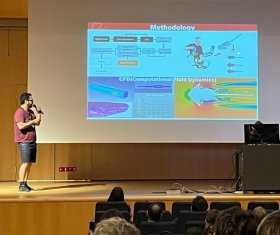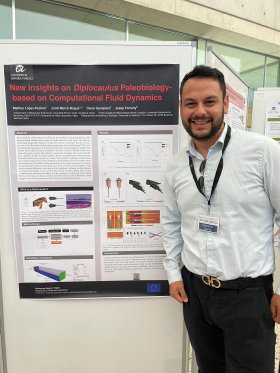Matheo López Pachón


PhD Programme: Nanoscience, Materials and Chemical Engineering
Research group: StEP – Social, cultural and biological evolution during the Pleistocene
Supervisors: Francisco Javier Huera-Huarte & Jordi Marcé-Nogué
Bio
Matheo began his research path in Bogotá, at Universidad Nacional de Colombia, where he graduated as a mechanical engineer (2015). He was a member of the GICAEPMA research group, where he collaborated on projects related to alternative fuels for the automotive sector. Additionally, he developed his undergraduate thesis with SIEMENS, by performing seismic resistance studies in E-HOUSES using the Finite Element Method (FEM). Afterward, he begins his professional life in the energy and oil sector, where he performs FEM and CFD (Computational fluid dynamics) simulations as a design and maintenance tool for the industry (2015-2017). Later, the Universidad de Los Andes awarded him a scholarship to pursue his master's studies. He studied vehicle aerodynamics using CFD and onboard experimentation on a Hatchback-type vehicle, determining the importance of lower vehicle details when performing CFD simulations as a thesis project (2018-2020). These studies allowed him to gain a position as a researcher in the Universidad de Los Andes geosciences department and he joined the "computational mechanics group". He was conducting fluid dynamics studies around physical topologies such as trilobites, crabs, etc., in cooperation with institutions such as the Complutense University of Madrid, Harvard, and Yale (USA). At the same time, he worked as a technical consultant in the Colombian government (ANLA entity), related to the dynamic test and vehicles by Montreal protocol. He is also co-founder of the Start-Up Colnabla, a company dedicated to computational support for engineering in all areas.
Project: Modelling bio-locomotion to shed light in the evolution of Lissamphibia clade
The lissamphibians (Lissamphibia) are a clade of vertebrates, including salamanders and newts. The ancestors of the current lissamphibians were the first animals to set foot on land and use terrestrial locomotion during the Devonian (between 416 and 360 million years ago). These animals had more or less developed limbs, and today, one of the great scientific questions that remain to be resolved is whether their life was mainly aquatic or terrestrial. The work presented is a multidisciplinary approach in which it is proposed to use computational and experimental methods of fluid mechanics to solve this question. The computational/experimental models should allow studying essential aspects of their locomotion concerning their ecology. Different digital techniques generate geometries of animal anatomy with precision. Then, it will be used to compare the results of different hydrodynamic parameters obtained (experimentally / computationally) with statistical and Machine Learning classification methods. This research project is characterized by its multidisciplinary nature, using methods from mechanical engineering to solve scientific questions in evolutionary biology and paleontology. It aims to close a question that is still unresolved today.
Open Access publications
- Jorge Esteve, Matheo López-Pachón (2023). Swimming and feeding in the Ordovician trilobite Microparia speciosa shed light on the early history of nektonic life habits. Palaeogeography, Palaeoclimatology, Palaeoecology, Volume 625, 111691. View full-text
Outreach activities
- European Researchers' Night 2023: "Parc de Fluídica".
Conferences
-
SICB+ (The Society for Integrative and Comparative Biology), 2023
-
EAVP (European Association of Vertebrate Palaeontologists), 2023
-
18th OpenFOAM Workshop, 2023



